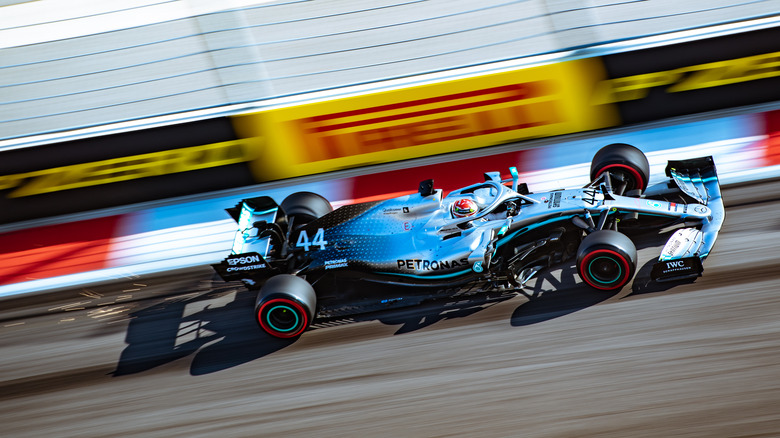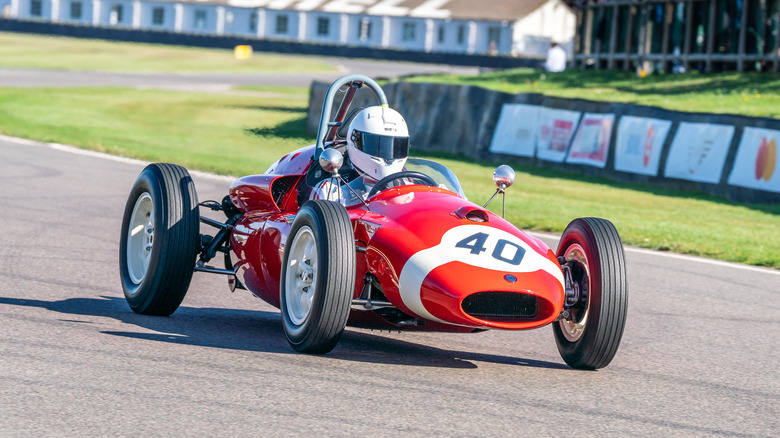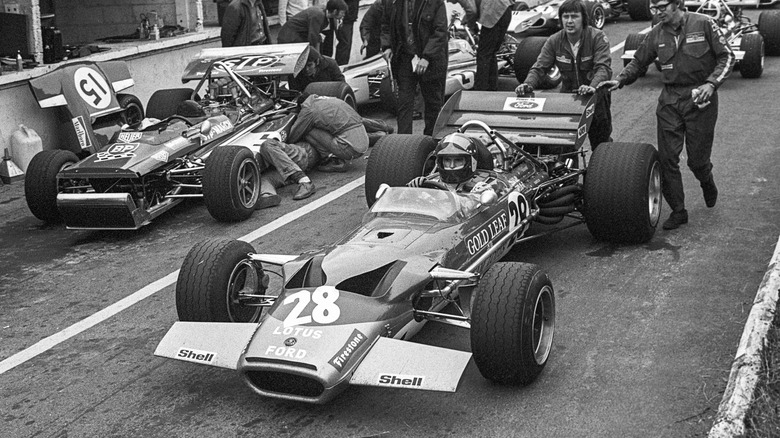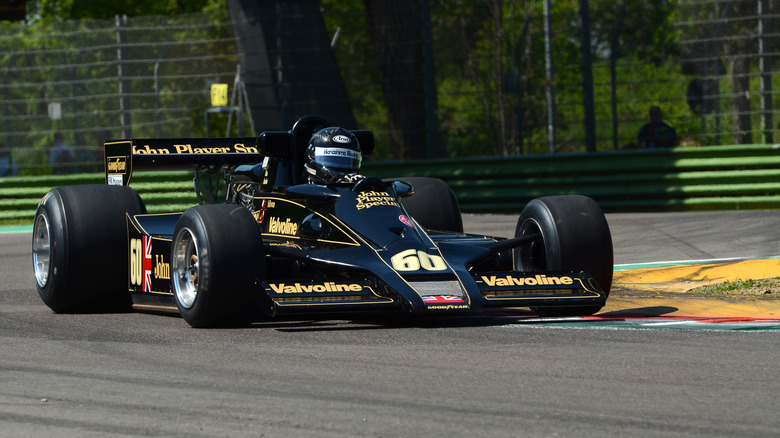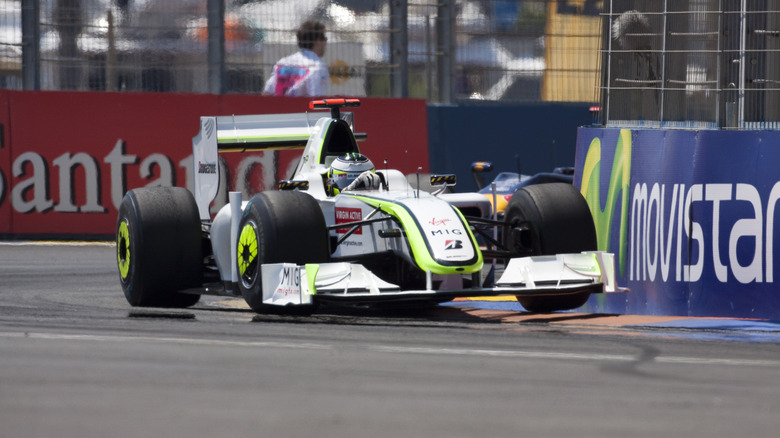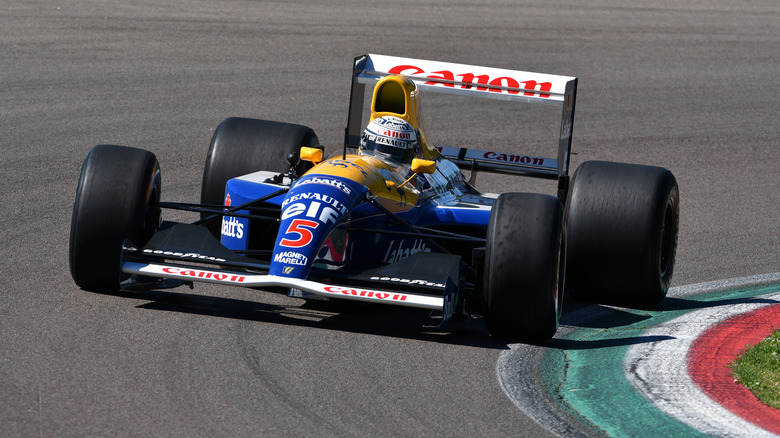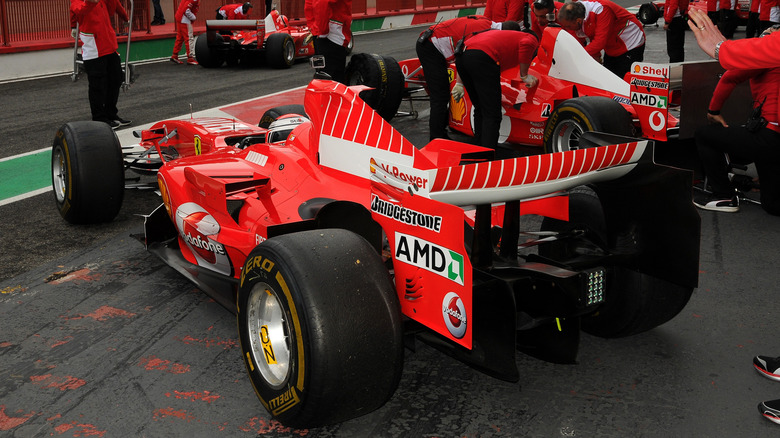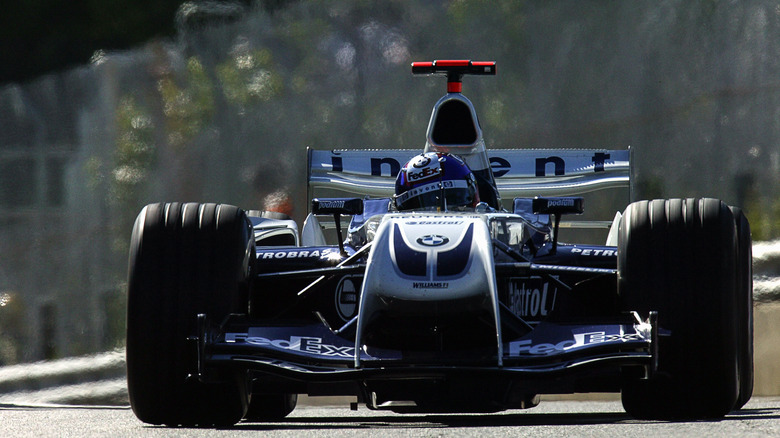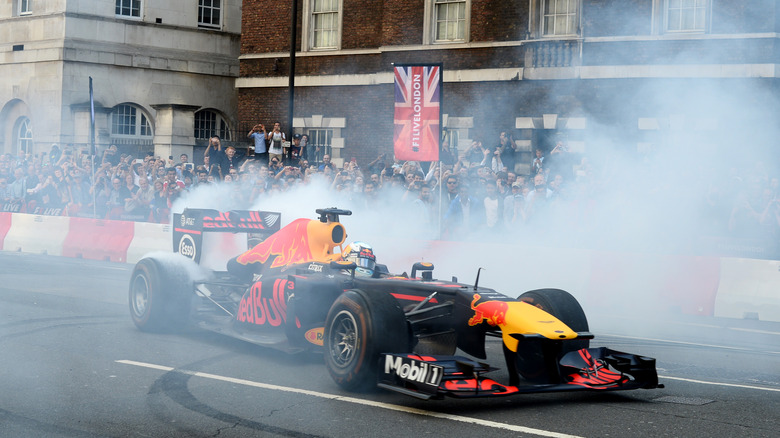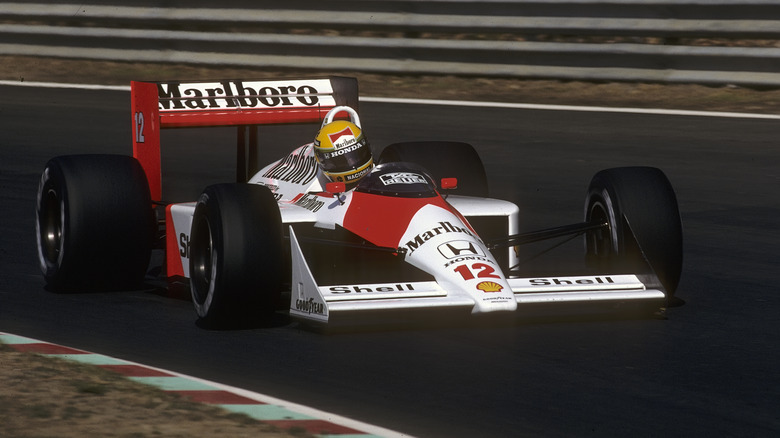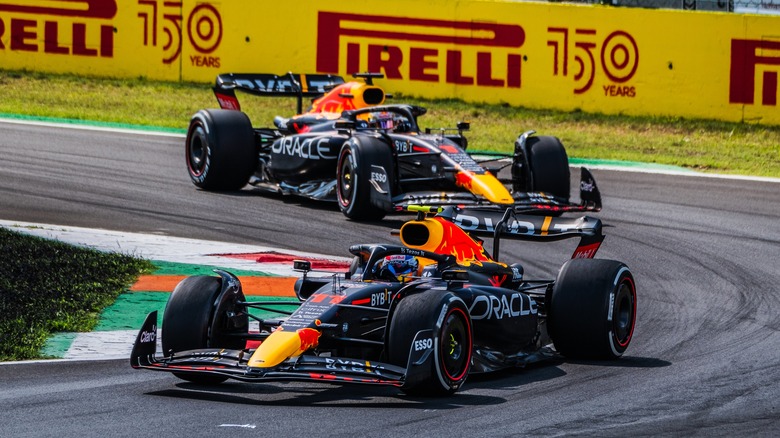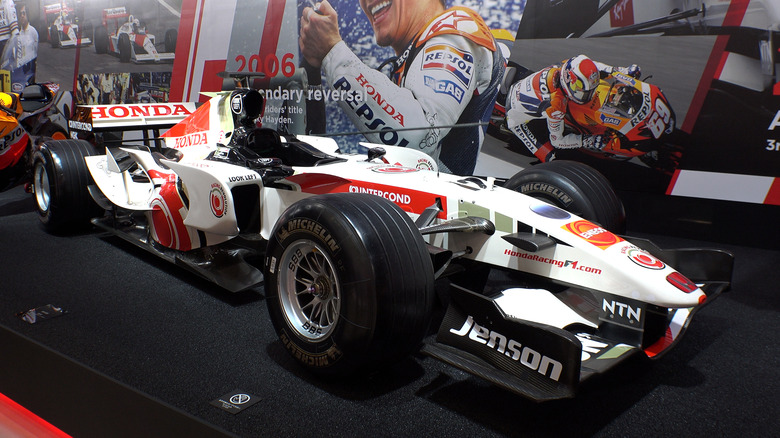The 12 Fastest F1 Cars Of All Time, Ranked
Formula One has been a sporting institution since 1946, when some of the world's finest auto manufacturers first competed to see whose vehicles and drivers performed the best around a dedicated circuit in Turin, Italy. The world championship followed in 1950, and the world's biggest trophy in motorsport has since been pursued by an ever-changing lineup of teams and drivers looking to prove that their machines can outperform the competition.
When ranking the fastest Formula One cars of all time, speed can be determined not only by how quickly they travel in a straight line but also by how they perform over the race distance, with driver skill, braking, handling, and reliability also playing important roles in their ultimate finish times. While specific construction regulations are enforced by the FIA (Formula One's governing authority), no two F1 cars are alike, and there are notable innovations employed by every team each season to improve performance and, ultimately, increase their speed. It is worth noting that FIA restrictions are also imposed from time to time, meaning that lap times can vary wildly from year to year.
Here we look at the most memorable machines to grace the long and eventful history of F1, with the many triumphs and catastrophes they experienced and the many novel innovations and revolutionary designs created to achieve the accolade of being one of the fastest F1 cars of all time. While no single standardized speed test has been agreed upon by all F1 teams, we've laid this list out using team-stated top speeds, race dominance in each vehicle's era, and in one case — fastest speed on the salt flats of South Africa.
12. Cooper T51 (1959)
Formula One was still in its relative infancy when the British Cooper team first entered the competition. Pioneered by a father and son team, the Cooper company (of Mini Cooper fame) went from strength to strength, ultimately creating one of the first rear-engine racing cars in the Cooper T51. Not only was this a highly competitive, quick machine, but it looked the part, with its sleek profile, long nose, and low-slung, forward driver position, which were all adopted by the generations of F1 cars to follow.
The T51 was raced by motor racing trailblazers Jack Brabham and Bruce McLaren (each of whom would later establish eponymous F1 teams). It originally sported a Coventry Climax 2,495-cc, four-cylinder engine, and a four-speed Citroen gearbox, although it later used Maserati and Ferrari engines and other transmissions. Its chassis was of tubular steel construction, and it had the unsophisticated double-wishbone suspension that was commonplace on race cars at the time.
With a top speed of 140 mph, the Cooper T51 was primitive by today's standards. Still, in its day, it was one of the most influential cars to enter Formula One, as this small, independent company revolutionized the way cars were designed and paved the way for faster, more streamlined vehicles later on.
11. Lotus 49 (1967)
The 1960s saw great leaps in the evolution of the Formula One car, as evidenced by the spectacular Lotus 49. Raced by F1 legends Jim Clark and Graham Hill, it hit top speeds of over 180 miles per hour, all the more impressive for a vehicle of this era, when safety features were barely existent, and road handling was relatively poor.
Design-wise, the Lotus 49 had some unique and innovative features, not least its stressed-member engine, which added to the strength of the chassis rather than having the chassis bear its weight. It also featured a monocoque, meaning that the car's shell was structural, which all modern F1 cars now use to reduce weight while improving their overall strength and safety. With a 2,998-cc Ford-Cosworth V8 engine that produced 415 brake horsepower at 9,500 rpm, the Lotus 49 ushered in a new era of high-powered racing that was soon to demand the introduction of large slick tires and spoilers to counteract the forces at play.
As the winner of two Drivers' and two Constructors' Championships in 1968 and 1970, the Lotus 49 left an indelible mark on racing history. It marked a turning point between the old school of single-seat mid-engine racers of the sixties and the next generation of low, wide, and highly aerodynamic machines that are still evolving today.
10. Lotus 78 (1978)
The Lotus 78 was as recognizable as it was notorious with its black and gold John Player Special cigarette livery. The car was driven to victory by Mario Andretti in the 1978 World Championship, winning Team Lotus the Constructors' Championship of the same year. Like the Lotus 49 and 72 before it, the 78 featured a naturally-aspirated Ford Cosworth three-liter V8 engine. But unlike its predecessors, which were increasingly less competitive, the 78 benefited from being the first car to use "ground effect" in Formula One motorsport.
Ground effect is the use of aerodynamics to produce downforce. This represented a sea change in Formula One racing as it allowed cars to corner at higher speeds, simultaneously reducing lap times and improving handling. The Lotus 78 used sculpted fiberglass bodywork with an inverted fiberglass wing and spoiler to produce an aerodynamically superior car with massive downforce that was unlike anything that came before.
The results spoke for themselves as the Lotus 78 cruised to victory in its debut year, winning five of the year's races and dominating the podium during the memorable 1978 season. Performance aside, it was also notable for its classic good looks. In fact, if this ranking were for the coolest-looking F1 cars, the Lotus 78 might well have been the winner.
9. Brawn BGP 001 (2009)
The 2009 season was one of the most memorable in recent F1 history, thanks to outliers Brawn GP and their incredible story. Originally Honda had a car in development, but they pulled out of the competition shortly before the start of the season. Ross Brawn, the Honda Team Principal, bought the team and quickly got to work readying the car, to be known as the Brawn BGP 001, for the looming championship. However, by the time of the first race, the car was far from ready, with a shoehorned Mercedes engine, mismatched parts, and balance issues.
The BGP 001 was, as it turned out, incredibly quick, often beating their main competitor Ferrari in qualifying, largely thanks to its controversial "double diffuser wing." This created a much more significant amount of downforce compared to the competitors' designs, and it was highly disputed but was eventually passed by the FIA upon appeal.
This gamble resulted in the most competitive car of the 2009 season, with two seasoned drivers, Jenson Button and Rubens Barrichello, behind the wheel. They often left the impressive Ferrari for dust, with Button eventually taking the Drivers' Championship, Brawn GP taking the Constructor's Championship, and Barrichello placing third.
8. Williams FW14B (1992)
Back in the days when Williams was a major competitor, it was the FW14B that earned them the most trophies, with a record nine wins in the 1992 season. Designed by Adrian Newey (later of McLaren and Red Bull), the FW14B was notable for being incredibly lightweight, with its carbon fiber chassis, and being technically advanced, thanks to its active suspension and traction control features.
Most importantly, it was very fast indeed. Helmed by legendary drivers Nigel Mansell and Riccardo Patrese, the Williams FW14B tore up the track from its debut at the South African Grand Prix. Throughout the season, the pair would often gain more than two seconds on their closest rivals, a considerable amount in racing terms.
Ultimately, Mansell would go on to win the Drivers' Championship, with Patrese taking second place and Williams dominating the Constructors' Championship for the entire season. Such was his admiration for the car that fellow driver Sebastian Vettel purchased Mansell's winning machine in 2020, perhaps the ultimate piece of F1 memorabilia for those with deep enough pockets.
7. Ferrari F2004 (2004)
To say that Michael Schumacher was the dominant driver at the turn of the century would be an understatement, and the formidable machine that carried him to his record-breaking seventh World Championship title was the Ferrari F2004. It seemed that nothing could touch Ferrari at this point. Under the technical direction of Ross Brawn, they improved upon every previous season right up until (and possibly forcing) the FIA's decision to impose regulations on the cars in the following years, which leveled the field.
The Ferrari F2004 won 15 out of the 18 races on that season's calendar (13 by Schumacher), making it one of the most dominant cars in F1 history. It is also one of the fastest, having set unbroken lap records at Monza, Magny-Cours, and Shanghai. Its success was buoyed by the requirement to build more resilient engines and gearboxes to meet racing standards that year, its excellent handling properties, and a top speed of 200 mph.
Schumacher and Ferrari won that year's Drivers' and Constructors' Championships, and the F2004 is undoubtedly one of the quickest cars the Italian marque has ever built. More than anything else, it is reminiscent of a time before FIA regulations, which, while making racing safer and more competitive, slows the pace of Formula One racing.
6. Williams BMW FW26 (2004)
While the Ferrari F2004 was almost unbeatable around a circuit, it wasn't necessarily the quickest car that year. Competing against the Ferrari in that same championship was the Williams BMW FW26, which Juan Pablo Montoya drove at an average speed of 162.950mph in qualifying. This was an F1 lap record at the time, although it was not official as it didn't occur during a race.
The car was aesthetically distinctive and dubbed the "walrus nose" due to its two vertical spars on either side of the nosecone, which gave it the appearance of having tusks while maximizing airflow. This quirky design proved very effective in testing, and the car was tipped as a favorite to win that year's competition. However, it was hampered by setup issues and could not maintain consistency under pressure.
The Williams BMW FW26 was a swansong for Williams as they never regained their glory years, and they would next win in Spain eight years later. This was probably the last genuinely competitive car Frank Williams' team produced, but at least they went out with a bang, not a whimper.
5. Red Bull RB7 (2011)
Few cars have been more successful than the Red Bull RB7. Towards the end of the 2000s, Red Bull emerged as a dominant team with Sebastian Vettel and Mark Webber as drivers. With 18 out of 19 pole positions and 12 wins in 2011, Sebastian Vettel continued his four-title run between 2010-2013 in this legendary machine, establishing Team Red Bull as a leading force in Formula One.
The RB7 was undoubtedly the best car in the 2011 championship by some margin, only finishing twice outside the top five places. It used a naturally-aspirated Renault V8 engine with a 2.4-liter capacity, had a 7-speed, semi-automatic transmission, and used the KERS kinetic energy recovery system that stores braking energy to provide an extra power boost when needed.
Despite its success, the Red Bull RB7 wasn't without its share of controversy due to its exhaust-blown diffuser, which was banned in later championships. Similar to the double diffuser on the Brawn BGP 001 (which the RB7 also utilized), the EBD used exhaust gases to create downforce. Other teams in the competition quickly mimicked this effective system, but Red Bull had enough of a head start on progress to outpace the other teams and secure a victory in 2011.
4. Mclaren Mp4-4 (1988)
Formula One history was written when Alain Prost and Ayrton Senna drove their McLaren Mp4-4 cars in the 1988 World Championship. While their rivalry and skill were well-documented both on and off the track, it was the car that stole the show, winning 15 out of the 16 races between them.
Designed by Steve Nichols, the MP4-4 had a 1.5-liter, 650 horsepower Honda V6 engine, which was significantly less powerful than its naturally-aspirated competitors' engines. It also had its fuel capacity restricted to 150 liters, but this, along with its smaller engine, resulted in a lightweight, ultra-streamlined car that was seriously competitive, landing Senna 13 poles out of 16. With few technical frills, the McLaren Mp4-4 resembled a go-kart on steroids and was the car that inspired many racing drivers, including Lewis Hamilton, from an early age.
The MP4-4 wiped the floor with the competition, with Senna winning the 1988 Drivers' Championship, Prost coming second, and McLaren winning their fourth Constructors' Championship title. Sadly, with Ayrton Senna's untimely death in 1994, when his Williams FW 16 crashed in the San Marino Grand Prix, this golden era of Formula One motorsport ended. But the 1988 season will forever live on in memory for demonstrating the perfect relationship between man and machine when pushed to the absolute limit of their abilities.
3. Red Bull RB18 (2022)
Red Bull has gone from strength to strength following their first championship win in 2010, but after 2014 they struggled in the shadow of their closest rival, Mercedes. This all changed in 2022 when they finally unseated the German team after their incredible 8-year run at the top, thanks to the persistence of drivers Max Verstappen and Sergio Perez and the excellent Red Bull RB18.
The FIA imposed new regulations regarding aerodynamics for the 2022 season, and Red Bull's designer Adrian Newey turned these to Red Bull's favor by creating a ground effect car that produced an incredible amount of downforce. As a result, the RB18 stuck to the track like glue, and this, coupled with a modified suspension, resulted in a car that handled well and was quick around the corners.
The Red Bull RB18 was also reliable, thanks to its small but powerful Honda power unit, and all these factors combined to produce one of the most consistent cars in that year's competition. The RB18 cruised to victory, with Verstappen winning 16 of the year's 22 Grands Prix and Perez winning two. Somewhat refreshingly for all but Mercedes fans, Red Bull was the new Constructors' Championship winner, with a new double World Champion in the young Dutch driver, the first time they celebrated a championship double since 2013.
2. Ferrari SF70H (2017)
While Mercedes and Red Bull had dominated Formula One since 2010, Ferrari always remained competitive and stood a good chance of winning the Constructors Championship with the SF70H in 2017. With two world champions, Kimi Räikkönen and Sebastian Vettel, driving the two prancing horses, Scuderia Ferrari's 70th-anniversary car was certainly one worth celebrating.
The SF70H sported a six-cylinder 1600-cc engine limited to 1,950 rpm, providing up to 1,000 horsepower. The car was large at five meters long and two meters wide, and its chassis was of a carbon fiber and honeycomb composite structure, making it light at 728 kilograms in weight. Its semiautomatic transmission was advanced, with eight forward gears and a quick shifter, and it featured carbon fiber disc brakes, all of which added to its blistering performance.
Having achieved 20 podiums in 20 races in 2017, the SF70H was incredibly fast. Sebastian Vettel and Scuderia Ferrari each finished second in their respective Championships that year. The Italian marque was given a significant confidence boost when Vettel finished first in that year's highly-popular Monaco Grand Prix, placing Ferrari firmly back in the limelight and giving their fans the enthusiastic "Tifosi," much to celebrate throughout the rest of the season.
1. Mercedes W11 (2020)
The Mercedes W11, or the Mercedes-AMG F1 W11 EQ Performance, to give it its less-catchy title, is one of the greatest Formula One cars in recent memory. Coming into the 2020 season, Mercedes were under increasing pressure from rivals Red Bull if they were to continue their six-year run as the sport's best constructors, and they had to deliver a car worthy of their seasoned drivers Lewis Hamilton and Valtteri Bottas.
The W11 was perfectly optimized with its Mercedes chassis, Mercedes transmission, and Mercedes V6 power unit producing 1,025 horsepower. Importantly, it kept Team Red Bull at bay for most of the season and even gave up-and-coming Mercedes star George Russell a chance to shine when he substituted for a COVID-stricken Hamilton, scoring the fastest lap in the Sakhir Grand Prix.
Having set numerous lap records on various circuits in 2020, the Mercedes W11 is often cited as the fastest F1 car of all time. Coupled with the unstoppable talent of Hamilton, it became a force to be reckoned with, winning both the Drivers' and Constructors' Championships and dominating that year's results with 25 podiums, 13 wins, and nine fastest laps (Bottas finished in second place). With the W11, Team Mercedes beat Ferrari's record six consecutive championships, continuing their run in 2021 to become the most successful constructors in Formula One history.
Methodology (and the 2006 Honda RA106)
So far, this list has ranked cars based on their on-track performance. This is arguably the fairest way to do things. While different tracks may make the results questionable, and different drivers will make a noticeable difference, it's the only way to account for every aspect of F1. Formula One is not drag racing. The list also takes achievements into account, as this also provides a solid cross section of F1 history. Without that, you may well be reading about 12 cars from the 2020 season.
But if we were just looking at maximum speed in a straight line, what would be the fastest? The answer is, we don't really know. Yes, we can compare specs, run simulators, and come up with a good guess — but as far as real world testing goes, there is no one universally accepted track/test on which all F1 teams agree to run. An F1 car won't max out on a track, and teams with tight budgets aren't going to spend a small fortune testing something that's ultimately useless to them.
There is one exception, but it isn't perfect. Honda took their 2006 RA106 out to some salt flats in South Africa and tested just how fast it could go. The answer is 256.753mph — which was just short of the team's 400 km/h target. There are a few issues. The car was modified for the salt flats, with a stability fin replacing the rear wing and restrictions on its engine removed . So it's not exactly what people saw on track. The 256 mph run couldn't be replicated the other way either, so the RA106's official record stands just short of 247 mph. So it's the only one tested, likely not actually the fastest F1 car, and slower than the fastest production car of its day.
